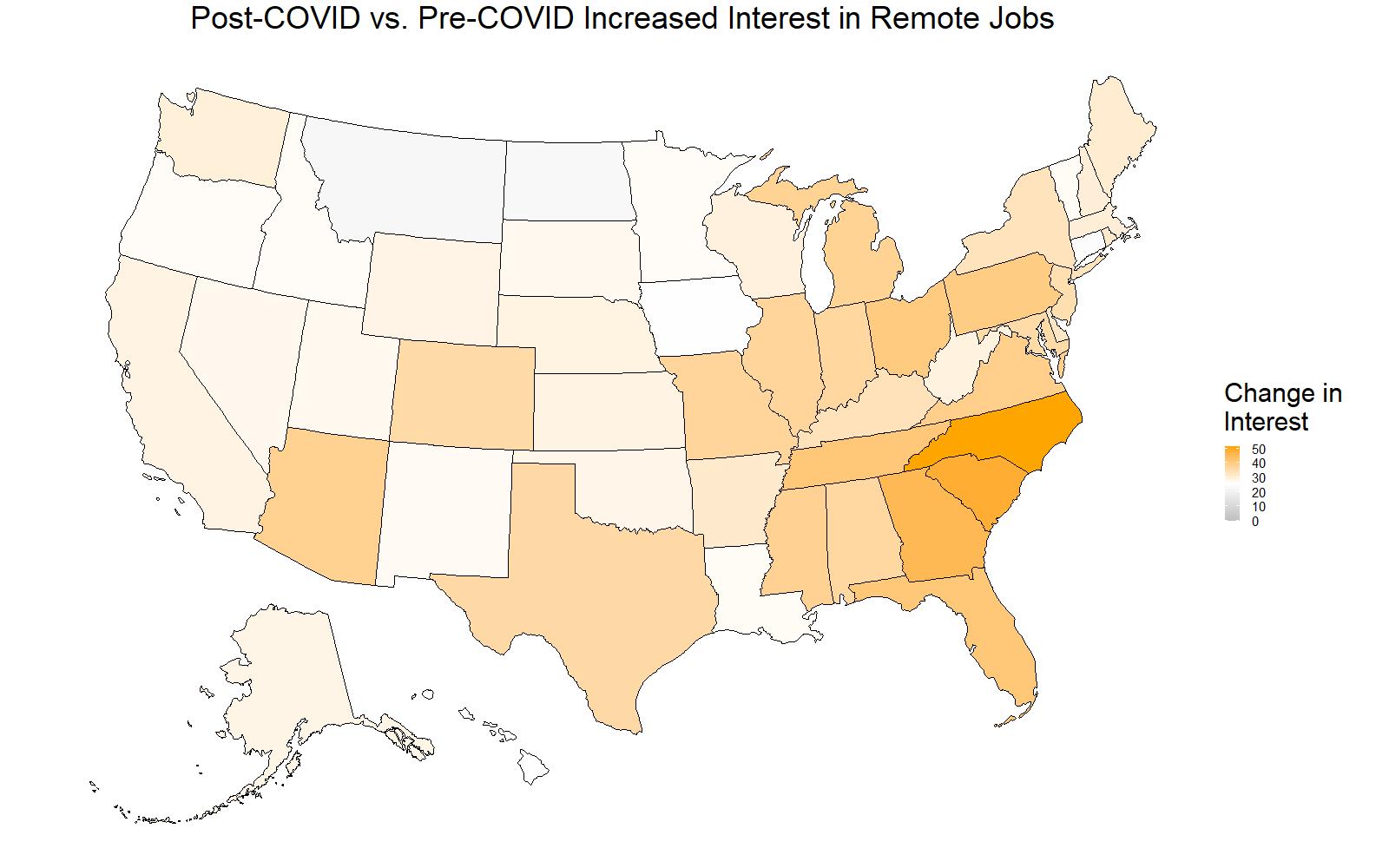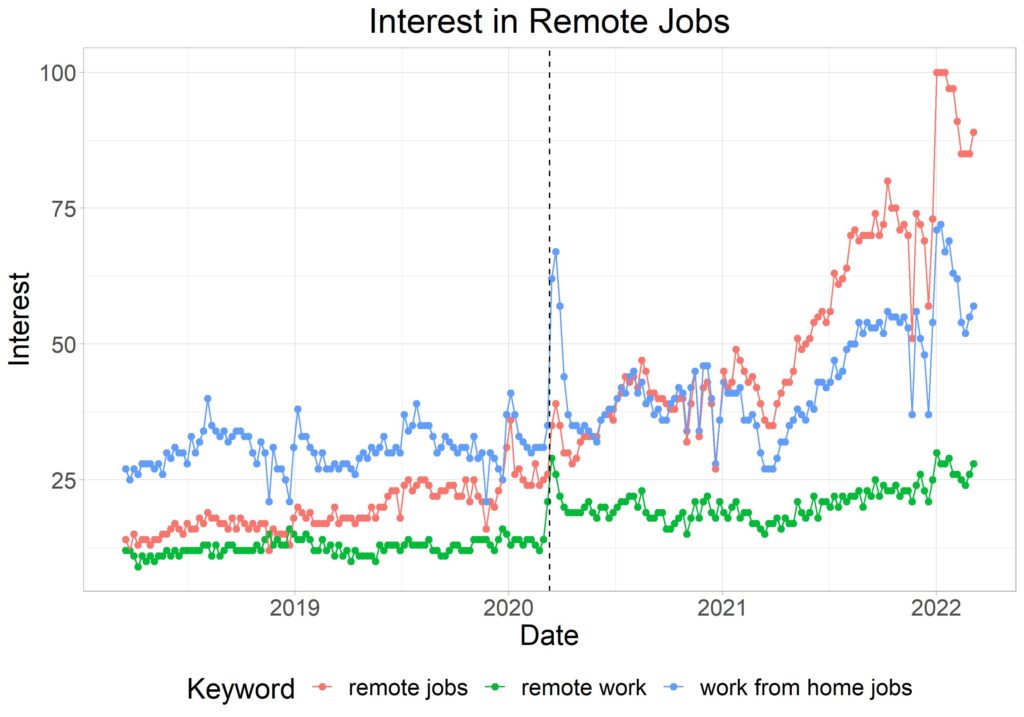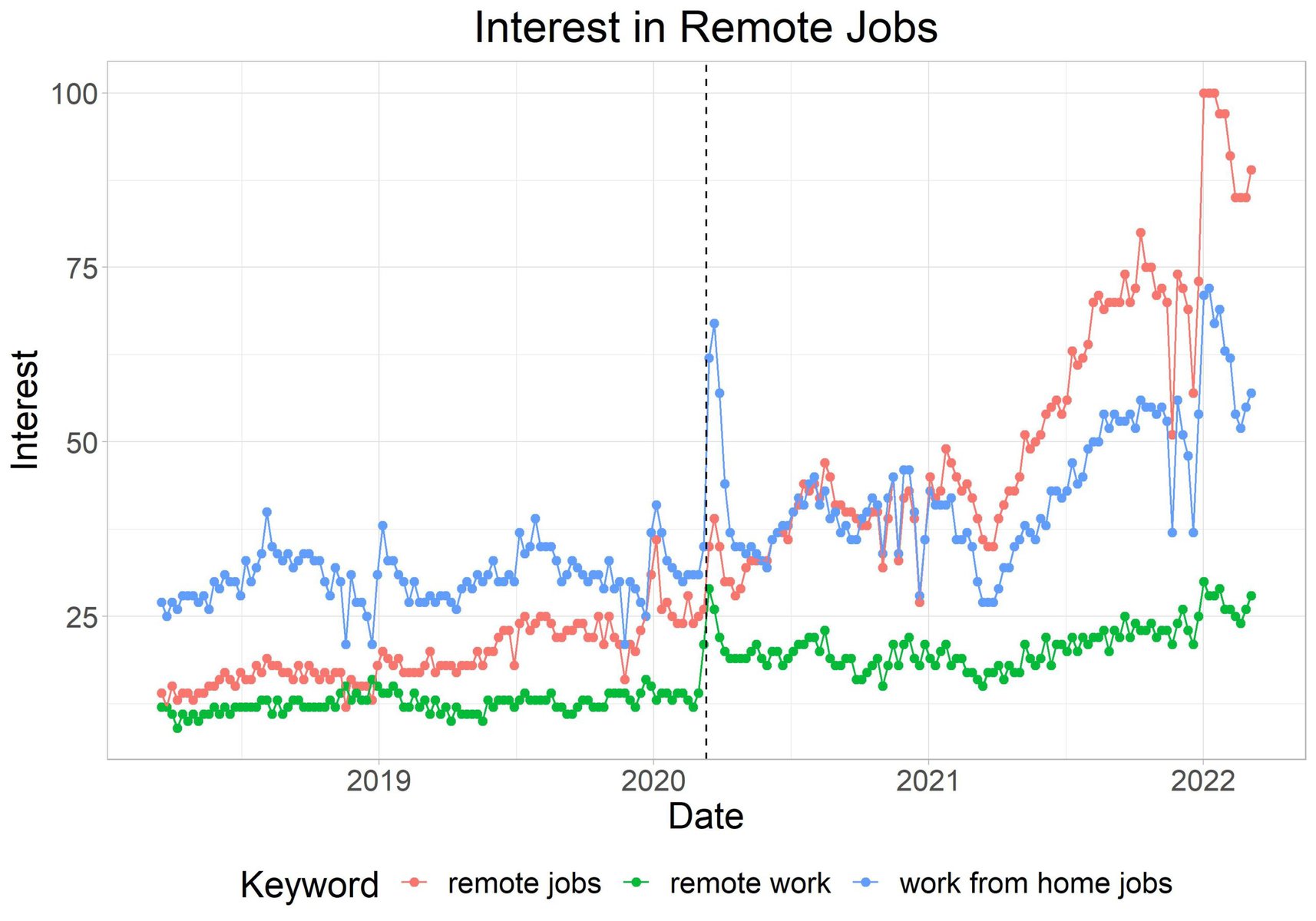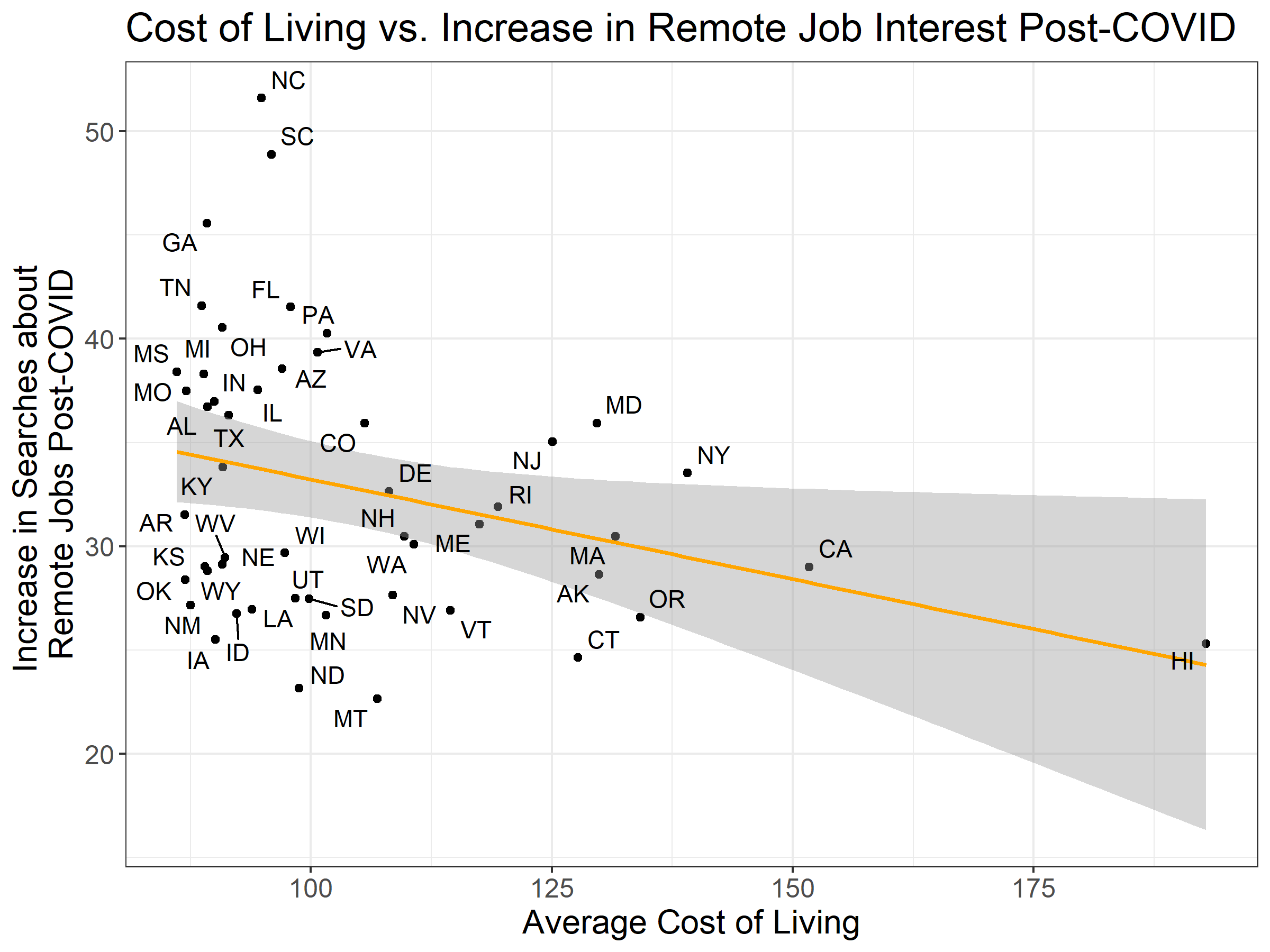
Report: Here are the States & Cities Where People are Most Interested in Remote Work
When the COVID-19 pandemic hit in 2020, companies all across the world shuttered their offices and began to operate remotely, allowing employees to work from the comfort of their homes. Not surprisingly, most employees immediately fell in love with working from home, enjoying the freedom and flexibility that comes with it.
As time has gone on and life has returned to something somewhat resembling normalcy, many businesses have started to ask their employees to return to the office. Some companies are requiring employees to be at the office on a full-time basis, while others are adopting a hybrid work schedule that lets employees work some days in the office and other days at home.
But not all workers have been ready to give up the remote work lifestyle. Over the last couple of years, employees have gained some leverage over employers in this labor market, and according to one recent study, only about half of all workers who have been asked by their employers to return to the office full time have actually complied.
Another recent survey found that 64% of workers would consider quitting if they were asked to return to the office full time.
The message is clear — most workers want the freedom to do their jobs from home.
But is that the case all across the country? Or are workers in certain regions more interested in remote work than others?
We worked together with a data science consulting firm to analyze and compare interest in remote working across all 50 states and many major metro areas across the US, looking at search trends and other publicly available data.
Here are the results of what we found…
Overview
Search interest in remote work opportunities has skyrocketed in recent years:
In the map below, you can see the increase in search interest in remote work opportunities prior to COVID and after COVID across the country. Some states have seen a bigger increase in interest in remote work than others:

State Rankings of Remote Work Interest
We calculated the increase in interest in remote jobs for each state by subtracting the interest before COVID from the interest after COVID. See the rankings below:
| STATE | INCREASE IN INTEREST |
| North Carolina | 51.6 |
| South Carolina | 48.9 |
| Georgia | 45.6 |
| Tennessee | 41.6 |
| Florida | 41.5 |
| Ohio | 40.5 |
| Pennsylvania | 40.3 |
| Virginia | 39.3 |
| Arizona | 38.6 |
| Mississippi | 38.4 |
| Michigan | 38.3 |
| Illinois | 37.5 |
| Missouri | 37.5 |
| Indiana | 37.0 |
| Alabama | 36.7 |
| Texas | 36.3 |
| Maryland | 35.9 |
| Colorado | 35.9 |
| New Jersey | 35.0 |
| Kentucky | 33.8 |
| New York | 33.5 |
| Delaware | 32.7 |
| Rhode Island | 31.9 |
| Arkansas | 31.5 |
| Maine | 31.1 |
| District of Columbia | 30.9 |
| New Hampshire | 30.5 |
| Massachusetts | 30.5 |
| Washington | 30.1 |
| Wisconsin | 29.7 |
| West Virginia | 29.5 |
| Nebraska | 29.1 |
| Kansas | 29.0 |
| California | 29.0 |
| Wyoming | 28.8 |
| Alaska | 28.6 |
| Oklahoma | 28.4 |
| Nevada | 27.6 |
| Utah | 27.5 |
| South Dakota | 27.5 |
| New Mexico | 27.2 |
| Louisiana | 26.9 |
| Vermont | 26.9 |
| Idaho | 26.8 |
| Minnesota | 26.7 |
| Oregon | 26.6 |
| Iowa | 25.5 |
| Hawaii | 25.3 |
| Connecticut | 24.6 |
| North Dakota | 23.2 |
| Montana | 22.6 |
City Rankings of Increase in Remote Work
We also calculated the increase in interest in remote work for around 200 metro areas across the country. These 50 metro areas have seen the biggest increase in interest:
| METRO AREA | INCREASE IN INTEREST |
| Columbus-Tupelo-West Point MS | 48.6 |
| Augusta GA | 46 |
| Charlottesville VA | 45.5 |
| Greenville-New Bern-Washington NC | 44.4 |
| Charlotte NC | 44.3 |
| Columbia SC | 43.9 |
| Hattiesburg-Laurel MS | 43.2 |
| Jackson TN | 43 |
| Jonesboro AR | 43 |
| Jackson MS | 41.6 |
| Macon GA | 41.3 |
| Gainesville FL | 40.7 |
| Montgomery (Selma) AL | 40 |
| Raleigh-Durham (Fayetteville) NC | 40 |
| Orlando-Daytona Beach-Melbourne FL | 39.9 |
| Atlanta GA | 39.5 |
| Binghamton NY | 38.9 |
| Watertown NY | 38.4 |
| Tampa-St. Petersburg (Sarasota) FL | 38.2 |
| Bend OR | 37.7 |
| Phoenix AZ | 37.5 |
| Charleston SC | 37.2 |
| Richmond-Petersburg VA | 37.2 |
| Florence-Myrtle Beach SC | 36.9 |
| Dallas-Ft. Worth TX | 36.2 |
| Memphis TN | 36 |
| Tallahassee FL-Thomasville GA | 35.8 |
| Waco-Temple-Bryan TX | 35.7 |
| Wilmington NC | 35.7 |
| Chicago IL | 35.4 |
| Wheeling WV-Steubenville OH | 35.3 |
| Dothan AL | 35.2 |
| Philadelphia PA | 34.9 |
| Greensboro-High Point-Winston Salem NC | 34.5 |
| Shreveport LA | 34.5 |
| Lansing MI | 34.4 |
| Nashville TN | 34.3 |
| Elmira NY | 34.2 |
| Denver CO | 33.9 |
| Tulsa OK | 33.9 |
| Harrisburg-Lancaster-Lebanon-York PA | 33.8 |
| Portland-Auburn ME | 33.8 |
| Washington DC (Hagerstown MD) | 33.7 |
| Birmingham AL | 33.4 |
| Paducah KY-Cape Girardeau MO-Harrisburg-Mount Vernon IL | 33.3 |
| Syracuse NY | 33.3 |
| Houston TX | 33.2 |
| Louisville KY | 33.2 |
| Little Rock-Pine Bluff AR | 33.1 |
| Columbia-Jefferson City MO | 33 |
Methodology
We extracted the frequency of searches in each state about remote work using a number of relevant search phrases. We then examined the differences in search frequencies for these keywords two years before COVID versus two years after the start COVID. We control for seasonal changes in remote job interest by comparing a full two years before COVID to a full two years after. We use March 11, 2020 as the official start of COVID-19 as this is when it was declared a pandemic in the US. We report the amounts searches for remote work increased in each state and city after COVID-19 began. We also examine the relationship between these trends and local cost of living in each area.
This post may contain affiliate links and we may earn commissions. Learn more in our disclosure.




